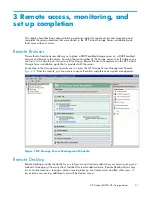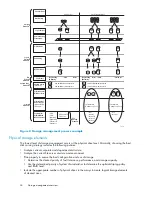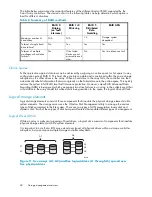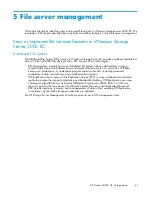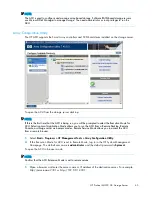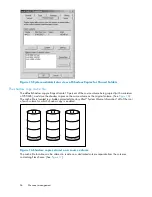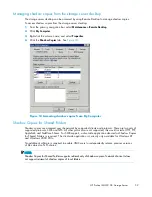
Con
fi
guring additional storage involves creating arrays, logical disks, and volumes.
Table 9
shows the
general task areas to be performed as well as the utilities needed to con
fi
gure storage for an HP Smart
Array-based storage server.
Table 9 Tasks and utilities needed for storage server con
fi
guration
Task
Storage management utility
Create disk arrays
HP Array Con
fi
guration Utility or Storage Manager
Create logical disks from the array space
HP Array Con
fi
guration Utility or Storage Manager
Verify newly created logical disks
Windows Disk Management
Create a volume on the new logical disk
Windows Disk Management
NOTE:
The type of con
fi
guration may not apply to all supported storage components and serves only as an
example providing basic guidance.
•
Create disk arrays—On storage servers with con
fi
gurable storage, physical disks can be
arranged as RAID arrays for fault tolerance and enhanced performance, and then segmented into
logical disks of appropriate sizes for particular storage needs. These logical disks then become
the volumes that appear as drives on the storage server.
CAUTION:
For hardware RAID-based storage servers, the
fi
rst controller has logical drives pre-con
fi
gured under
Array A. These logical drives are con
fi
gured for the storage server operating system and should not
be altered in any manner.
The fault tolerance level depends on the amount of disks selected when the array was created.
A minimum of two disks is required for RAID 0+1 con
fi
guration, three disks for a RAID 5
con
fi
guration, and four disks for a RAID 6 (ADG) con
fi
guration.
•
Create logical disks from the array space—Select the desired fault tolerance, stripe size, and
size of the logical disk.
•
Verify newly created logical disks—Verify that disks matching the newly created sizes are
displayed.
•
Create a volume on the new logical disk—Select a drive letter and enter a volume label, volume
size, allocation unit size, and mount point (if desired).
NOTE:
Do not tamper with the “DON’T ERASE” or local C: volume. These are reserved volumes and must
be maintained as they exist.
Storage management utilities
The storage management utilities pre-installed on the storage server include the HP Array Con
fi
guration
Utility (ACU).
Array management utilities
Storage devices for RAID arrays and LUNs are created and managed using the array management
utilities mentioned previously. For HP Smart Arrays use the ACU.
44
File server management
Summary of Contents for ProLiant ML350 G5
Page 10: ...10 ...
Page 22: ...22 The HP storage server solution ...
Page 86: ...86 Print services ...
Page 118: ...118 Network adapter teaming ...


